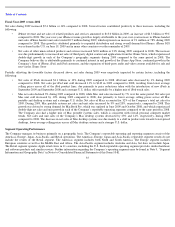Apple 2010 Annual Report Download - page 40
Download and view the complete annual report
Please find page 40 of the 2010 Apple annual report below. You can navigate through the pages in the report by either clicking on the pages listed below, or by using the keyword search tool below to find specific information within the annual report.
Table of Contents
Asia
-Pacific
Net sales in Asia
-Pacific increased $5.1 billion or 160% during 2010 compared to 2009. The significant growth in Asia-
Pacific net sales was due
mainly to increased iPhone revenue, which was primarily attributable to country and carrier expansion and continued growth from existing
carriers. Asia-
Pacific net sales were also favorably affected by strong demand for Mac portable and desktop systems and for iPad. Particularly
strong year-over-year growth was experienced in China, Korea and Australia. The Asia-
Pacific segment represented 13% and 7% of the
Company’s total net sales for 2010 and 2009, respectively.
Net sales in Asia
-
Pacific increased $493 million or 18% during 2009 compared to 2008 reflecting strong growth in sales of iPhone and Mac
portable systems, offset partially by a decline in sales of iPods and Mac desktop systems, as well as a strengthening of the U.S. dollar against the
Australian dollar and other Asian currencies. Mac net sales and unit sales grew in the Asia-
Pacific region by 4% and 17%, respectively, due to
increased sales of the MacBook Pro. The Asia-Pacific segment represented approximately 7% of the Company’
s total net sales in both 2009 and
2008.
Retail
Retail net sales increased $3.1 billion or 47% during 2010 compared to 2009. The increase in net sales was driven primarily by strong demand
for iPad, increased sales of Mac desktop and portable systems and a significant year-over-
year increase in iPhone revenue. Mac net sales and
unit sales grew in the Retail segment by 25% and 35%, respectively, during 2010. The Company opened 44 new retail stores during the year, 28
of which were international stores, ending the year with 317 stores open compared to 273 stores at the end of 2009. With an average of 288
stores and 254 stores opened during 2010 and 2009, respectively, average revenue per store increased to $34.1 million in 2010, compared to
$26.2 million in 2009. The Retail segment represented 15% and 16% of the Company’s total net sales in 2010 and 2009, respectively.
Retail net sales decreased $636 million or 9% during 2009 compared to 2008. The decline in net sales was driven largely by a decrease in net
sales of iPhones, iPods and Mac desktop systems, offset partially by strong demand for Mac portable systems. The year-over-
year decline in
Retail net sales was attributable to continued third-party channel expansion, particularly in the U.S. where most of the Company’
s stores are
located, and also reflects the challenging consumer-
spending environment in 2009. The Company opened 26 new retail stores during 2009,
including 14 international stores, ending the year with 273 stores open. This compares to 247 stores open as of September 27, 2008. With an
average of 254 stores and 211 stores opened during 2009 and 2008, respectively, average revenue per store decreased to $26.2 million for 2009
from $34.6 million in 2008.
The Retail segment reported operating income of $2.4 billion during 2010 and $1.7 billion during both 2009 and 2008. The increase in Retail
operating income during 2010 compared to 2009 was attributable to higher overall net sales. Despite the decline in Retail net sales during 2009
compared to 2008, the Retail segment’
s operating income was flat at $1.7 billion in 2009 compared to 2008 due primarily to a higher gross
margin percentage in 2009 consistent with that experienced by the overall company.
Expansion of the Retail segment has required and will continue to require a substantial investment in fixed assets and related infrastructure,
operating lease commitments, personnel, and other operating expenses. Capital asset purchases associated with the Retail segment since its
inception totaled $2.2 billion through the end of 2010. As of September 25, 2010, the Retail segment had approximately 26,500 full-
time
equivalent employees and had outstanding lease commitments associated with retail space and related facilities of $1.7 billion. The Company
would incur substantial costs if it were to close multiple retail stores and such costs could adversely affect the Company’
s financial condition and
operating results.
37
























